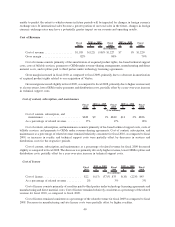Symantec 2010 Annual Report Download - page 109
Download and view the complete annual report
Please find page 109 of the 2010 Symantec annual report below. You can navigate through the pages in the report by either clicking on the pages listed below, or by using the keyword search tool below to find specific information within the annual report.We record impairment charges on developed technology or acquired product rights when we determine that the
net realizable value of the assets may not be recoverable. To determine the net realizable value of the assets, we use
the estimated future gross revenue from each product. Our estimated future gross revenue of each product is based
on company forecasts and is subject to change.
Long-Lived Assets (including Assets Held for Sale). We assess long-lived assets to be held and used for
impairment whenever events or changes in circumstances indicate that the carrying value of the long-lived assets
may not be recoverable. Based on the existence of one or more indicators of impairment, we measure any
impairment of long-lived assets based on a projected undiscounted cash flow method using assumptions determined
by management to be commensurate with the risk inherent in our current business model. Our estimates of cash
flows require significant judgment based on our historical and anticipated results and are subject to many factors
which could change and cause a material impact to our operating results or financial condition. We record
impairment charges on long-lived assets held for sale when we determine that the carrying value of the long-lived
assets may not be recoverable. In determining our fair value, we obtain and consider market value appraisal
information from third-parties.
Fair Value of Financial Instruments
The assessment of fair value for our financial instruments is based on the authoritative guidance on fair value
measurements which establishes a fair value hierarchy that is based on three levels of inputs and requires an entity to
maximize the use of observable inputs and minimize the use of unobservable inputs when measuring fair value.
We use inputs such as actual trade data, benchmark yields, broker/dealer quotes and other similar data which
are obtained from independent pricing vendors, quoted market prices or other sources to determine the ultimate fair
value of our assets and liabilities. We use such pricing data as the primary input, to which we have not made any
material adjustments, to make our assessments and determinations as to the ultimate valuation of our investment
portfolio, and we are ultimately responsible for the financial statements and underlying estimates. The fair value
and inputs are reviewed for reasonableness, may be further validated by comparison to publicly available
information and could be adjusted based on market indices or other information that management deems material
to their estimate of fair value.
As of April 2, 2010, our financial instruments measured at fair value on a recurring basis included $2.4 billion
of assets. Our cash equivalents primarily consist of money market funds, bank securities, and government securities
and represent 99% of our total financial instruments measured at fair value on a recurring basis.
As of April 2, 2010, $2.1 billion of investments were classified as Level 1, most of which represents
investments in money market funds. These were classified as Level 1 because their valuations were based on quoted
prices for identical securities in active markets. Determining fair value for Level 1 instruments generally does not
require significant management judgment.
As of April 2, 2010, $342 million of investments were classified as Level 2, of which $216 million and
$116 million (representing a combined 97% of Level 2 financial instruments) represent investments in bank
securities and government securities, respectively. These were classified as Level 2 because either (1) the estimated
fair value is based on the fair value of similar securities or (2) their valuations were based on pricing models with all
significant inputs derived from or corroborated by observable market prices for identical securities in markets with
insufficient volume or infrequent transactions (less active markets). Level 2 inputs generally are based on non-
binding market consensus prices that are corroborated by observable market data; quoted prices for similar
instruments; and/or model-derived valuations in which all significant inputs are observable or can be derived
principally from or corroborated with observable market data for substantially the full term of the assets or liabilities
or quoted prices for similar assets or liabilities. While determining the fair value for Level 2 instruments does not
necessarily require significant management judgment, it generally involves the following level of judgment and
subjectivity:
• Determining whether a market is considered active- An assessment of an active market for marketable
securities generally takes into consideration whether a trading market exists for a given instrument or trading
volume for each instrument type. Our Level 2 financial instruments were classified due to either low trading
33
























